The demand for caramel food colors in Japan is valued at USD 11.2 million in 2025 and is projected to reach USD 28.4 million by 2035, reflecting a CAGR of 9.8%. In the first phase of the forecast (2025-2030), demand is expected to grow steadily, increasing from USD 11.2 million to approximately USD 17.8 million by 2030. This growth is driven by the expanding use of caramel food colors in the food and beverage industry, particularly in confectionery, dairy, and baked goods. As consumer preferences shift toward natural food colorants and increased demand for aesthetically appealing products, the market for caramel food colors continues to rise.
From 2030 to 2035, the demand for caramel food colors will maintain a robust growth trajectory, reaching USD 28.4 million by 2035. This phase is marked by accelerated adoption of caramel colors in processed and packaged foods, driven by consumer demand for clean-label products and natural ingredients. The market will also benefit from ongoing advancements in food safety regulations and growing consumer awareness of product ingredients. The increasing trend toward health-conscious eating and the rising popularity of caramelized flavors will contribute to the continued strong demand for caramel food colors in Japan throughout the forecast period.

Between 2025 and 2030, the demand for Caramel Food Colors in Japan is expected to grow from USD 11.2 million to USD 12.3 million, representing an increase of USD 1.1 million. This period will exhibit a compound annual growth rate (CAGR) of 9.8%, driven by the increasing preference for natural and clean-label ingredients in food and beverages. As consumers demand healthier and more transparent food products, caramel food colors will gain popularity due to their versatility in various applications, including confectionery, dairy, and beverages. Manufacturers will focus on product innovation and meeting evolving regulatory standards, contributing to steady growth during this phase.
From 2030 to 2035, the demand for Caramel Food Colors is projected to rise from USD 12.3 million to USD 28.4 million, adding USD 16.1 million to the market. This phase will see a significant acceleration in growth, driven by the expanding popularity of caramel colors in ready-to-eat meals, processed foods, and beverages. The continued shift towards natural ingredients, coupled with greater awareness of product transparency and sustainability, will fuel this demand. Key players in the region will invest in research and development, offering new solutions to meet both aesthetic needs and regulatory requirements, further propelling market expansion.
| Metric | Value |
|---|---|
| Industry Value (2025) | USD 11.2 million |
| Forecast Value (2035) | USD 28.4 million |
| Forecast CAGR (2025 to 2035) | 9.8% |
The demand for caramel food colors in Japan has been influenced by historical trends within processed foods and beverages. Traditionally, applications in soft drinks, sauces, confectioneries and baked goods have leaned on caramel‐colored additives to intensify brown or amber hues and compensate for natural colour variation. The mature food processing sector in Japan, with high standards for visual presentation and consistency, has supported adoption of caramel food colours. At the same time, the growing premiumisation of snack and bakery products facilitated incremental uptake of higher‐specification caramel colourants, while regulatory oversight on food additive quality reinforced reliable supply chains and certification practices.
Looking ahead, future demand in Japan is expected to be shaped by several evolving factors. First, cleaner‐label and naturally sourced colouring agents are increasingly relevant, so manufacturers of caramel food colours that meet these expectations will likely benefit. Second, continued growth in convenience foods, ready‐to‐eat meals and packaged bakery items supports sustained use of caramel colourants where brown or golden tones are desired. Third, although regulatory scrutiny and cost pressures continue, the incremental value placed on visual appeal and product differentiation suggests that caramel food colours will maintain relevance within the broader food colour portfolio in Japan.
The demand for caramel food colors in Japan is driven by both the type and application. The primary types include plain, ammonia, sulphite ammonia, and caustic sulphite, with plain caramel food color accounting for 34% of the total demand. In terms of application, caramel food colors are predominantly used in beverages, bakery products, dairy items, snacks & cereals, and sauces, with beverages accounting for 20% of the total demand. These segments reflect the broad use of caramel colors across various food and beverage categories, with the need to enhance visual appeal and consistency in finished products being a key factor.

Plain caramel food color leads the demand in Japan, representing 34% of the total market. This type of caramel color is preferred for its versatility and ease of use in a wide range of food and beverage applications. Plain caramel offers a stable, consistent color that meets the aesthetic needs of manufacturers, particularly in products like beverages and bakery items. It is widely accepted due to its neutral flavor profile, which does not interfere with the taste of the product. The growing demand for visually appealing, natural-looking products in Japan’s food sector further drives the preference for plain caramel food colors.
The popularity of plain caramel food colors can also be attributed to their suitability for various regulatory standards, as they are generally considered safe for consumption in a wide range of products. As consumers increasingly demand products with natural, appealing colors, the demand for plain caramel food colors is expected to continue growing. In Japan, where food presentation plays a significant role in consumer choices, plain caramel food colors provide manufacturers with a reliable and cost-effective solution for enhancing product appearance without compromising on flavor.
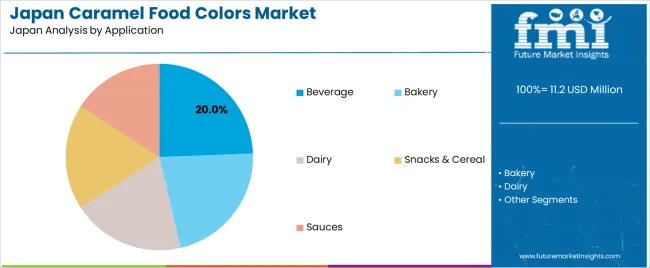
The beverage sector accounts for 20% of the total demand for caramel food colors in Japan. This demand is driven by the need for beverages to maintain an appealing color and consistent look. Caramel food colors are widely used in a variety of drinks, including soft drinks, alcoholic beverages, and health drinks, to enhance their visual appeal. The neutral flavor of caramel food colors ensures that they can be used in beverages without affecting taste, making them ideal for a broad range of applications. Additionally, the growing popularity of ready-to-drink beverages in Japan continues to support the demand for these colorants.
The use of caramel colors in beverages is also influenced by consumer preferences for natural and aesthetically pleasing products. Beverage manufacturers in Japan are increasingly adopting caramel food colors to meet the demand for visually consistent and attractive drinks. The increasing consumption of bottled beverages, along with the rise of specialty drinks such as craft sodas and non-alcoholic beverages, further drives the demand for caramel food colors in this sector. As the beverage industry continues to innovate, the demand for high-quality caramel food colors is expected to remain strong.
Demand for caramel food colours in Japan is being driven by the country’s large packaged food and beverage sector, where products such as soft drinks, sauces, confectionery and baked goods rely on stable brown toned colourants. Japanese manufacturers face pressure from retailers and consumers for consistent colour appearance in familiar flavour profiles, making caramel colours preferred. Growth in ready to drink beverages and convenience store dessert formats also supports this demand. Domestic emphasis on product appearance and shelf appeal further elevates the use of caramel food colours. These local consumption and production dynamics underpin the rising uptake of caramel based colourants in Japan.
The growth of caramel food colours in Japan is constrained by regulatory scrutiny over food additives and consumer awareness of "clean label" ingredients. Some Japanese food producers are shifting toward naturally derived colourants or minimal processing claims, reducing reliance on traditional caramel colourants. Import dependence on specific raw material grades and fluctuating supply pricing add cost pressures for domestic formulators. Additionally, retrofitting formulations to accommodate stricter food safety or allergen friendly requirements can delay adoption. These regulatory, cost and formulation transition factors act as material restraints on the expansion of caramel food colour demand in Japan.
In Japan the trend is toward premiumisation of food and beverage products, which includes finer colour consistency and higher grade additives. Manufacturers of caramel food colours are supplying variants with reduced heavy metal residuals, improved solubility and trace ability. Furthermore, the rise in dark coloured beverages, flavoured coffees and craft sauces in Japan is steering demand toward richer brown colour profiles. At the same time, food service and e commerce packaging formats requiring high visual impact are driving innovation in caramel colour applications. These trends suggest an evolving role for caramel food colours beyond basic colouring towards premium, functional and visually differentiated uses in Japan.
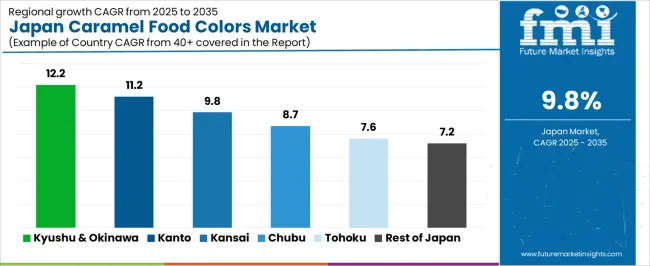
| Region | CAGR (%) |
|---|---|
| Kyushu & Okinawa | 12.2% |
| Kanto | 11.2% |
| Kinki | 9.8% |
| Chubu | 8.7% |
| Tohoku | 7.6% |
| Rest of Japan | 7.2% |
The demand for caramel food colors in Japan is rising at differing rates across regions. In Kyushu & Okinawa the CAGR is 12.2% the highest driven by regional confectionery production, bakery expansions and demand for premium packaging with rich colours. The Kanto region follows at 11.2%, supported by its large food and beverage manufacturing base, high usage in soft drinks and sauces, and innovation in flavoured snacks. The Kinki region records 9.8% growth as local manufacturers upgrade colour systems and respond to consumer preference for visually appealing foods. The Chubu region’s 8.7% CAGR reflects moderate industrial growth. Tohoku at 7.6% and the Rest of Japan at 7.2% show slower uptake due to smaller-scale operations and less dense manufacturing.
In Kyushu & Okinawa, the demand for caramel food colors is growing at a CAGR of 12.2% through 2035. The increase is driven by the rising consumption of processed food and beverages, where caramel food colors are widely used to enhance visual appeal. The foodservice and hospitality industries in Okinawa, especially with the region’s growing tourism sector, are also contributing to this demand. As local manufacturers expand their production to meet both domestic and international needs, caramel food colors are becoming increasingly popular as a safe and effective coloring agent in food and beverages.
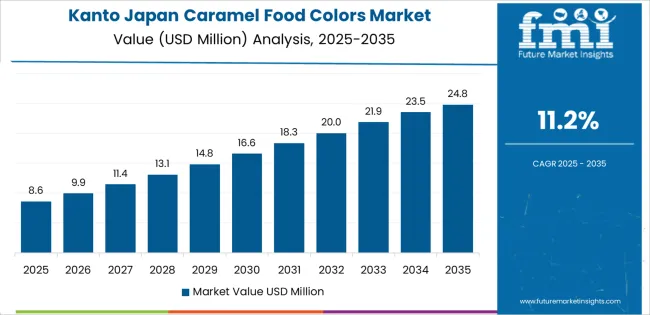
In Kanto, the demand for caramel food colors is projected to grow at a CAGR of 11.2% through 2035. As Japan's largest economic region, Kanto has a highly developed food manufacturing and beverage industry, both of which are major consumers of caramel food colors. The increasing trend toward natural ingredients in food production is supporting the demand for caramel food colors, which are often perceived as a safer, more natural option. Additionally, the region’s vast retail and foodservice sectors are contributing to the adoption of caramel food colors in various products.
In Kinki, the demand for caramel food colors is expected to grow at a CAGR of 9.8% through 2035. The region’s robust food processing and beverage sectors are key drivers of demand for food colorants. As consumer preferences shift toward aesthetically appealing and high-quality food products, the adoption of caramel food colors in both the food manufacturing and foodservice industries is increasing. Additionally, growing interest in natural and safe food additives is contributing to the demand for caramel food colors, which are widely used in a range of food and beverage products.
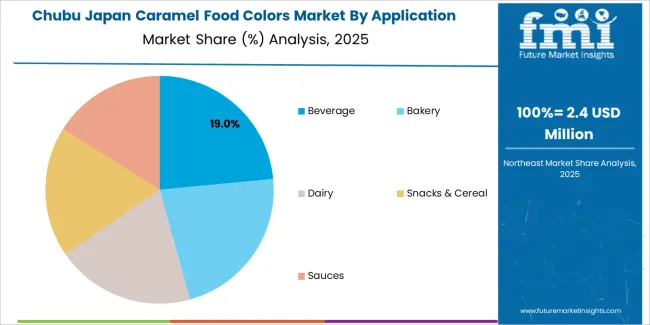
In Chubu, the demand for caramel food colors is projected to grow at a CAGR of 8.7% through 2035. The demand is driven by the food manufacturing sector, which is expanding to meet consumer needs for high-quality food products. As food manufacturers in Chubu adopt more sustainable and natural food additives, caramel food colors are increasingly seen as a preferred option. The growth in local food processing and packaging industries is also contributing to the adoption of caramel food colors for a wide range of applications in processed food and beverages.
In Tohoku, the demand for caramel food colors is expected to grow at a CAGR of 7.6% through 2035. While Tohoku’s food manufacturing sector is smaller compared to other regions, the increasing popularity of processed foods and beverages is driving demand for caramel food colors. Local food manufacturers are adopting caramel food colors to enhance the visual appeal and quality of their products, particularly in the snack and confectionery sectors. As consumer awareness of the importance of food safety and natural ingredients grows, the adoption of caramel food colors continues to rise in Tohoku.
In the rest of Japan, the demand for caramel food colors is projected to grow at a CAGR of 7.2% through 2035. Regional food manufacturers outside the major industrial hubs are increasingly adopting caramel food colors in response to the growing demand for visually appealing food products. The increasing focus on sustainable and natural food ingredients is contributing to the shift toward caramel food colors. Additionally, as local industries expand to meet domestic and export demands, the adoption of caramel food colors is expected to rise steadily across these regions.
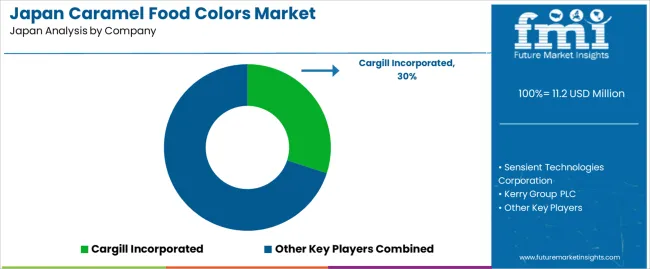
The demand for caramel food colors in Japan is driven by the growth of the country’s processed food and beverage sectors coupled with rising expectations for visual appeal in consumer goods. Manufacturers of bakery items, confectionery, and ready to eat snacks value caramel color for its ability to deliver consistent brown hues across formulations. The beverage industry also relies on it to achieve desired tones in both non alcoholic and alcoholic drinks. Japan’s regulatory environment and emphasis on ingredient traceability raise the bar for performance and safety in color additives. At the same time, increasing cost pressures and shifts in consumer preference toward cleaner ingredient lists create tension between demand and formulation constraints.
Companies such as Cargill Incorporated, Sensient Technologies Corporation, Kerry Group PLC, DDW, The Color House and Sethness Caramel Color play central roles in Japan’s caramel food color market. These firms offer a mix of standard and tailor made caramel color solutions designed for Japan’s food processing landscape. Their global scale supports extensive distribution and technical support while their localized offerings respond to Japanese formulators’ demands for heat stable, acid resistant and clean label compliant colorants. They continue to invest in custom shade portfolios, smaller batch flexibility and regulatory compliance to maintain relevance in the Japanese environment.
| Items | Values |
|---|---|
| Quantitative Units (2025) | USD million |
| Type | Plain, Ammonia, Sulphite Ammonia, Caustic Sulphite |
| Application | Beverage, Bakery, Dairy, Snacks & Cereal, Sauces |
| Region | Kyushu & Okinawa, Kanto, Kinki, Chubu, Tohoku, Rest of Japan |
| Countries Covered | Japan |
| Key Companies Profiled | Cargill Incorporated, Sensient Technologies Corporation, Kerry Group PLC, DDW, The Color House, Sethness Caramel Color |
| Additional Attributes | Dollar by sales by type, application, and region; regional CAGR and adoption trends; volume and value growth projections; regulations surrounding food colorants for various industries; innovations in caramel color applications for health-conscious eating trends; clean-label product demands; food safety compliance and ingredient traceability; caramelized flavor popularity; investment in research and development for custom shade portfolios; impact of sustainability on caramel color use. |
The demand for caramel food colors in Japan is estimated to be valued at USD 11.2 million in 2025.
The market size for the caramel food colors in Japan is projected to reach USD 28.4 million by 2035.
The demand for caramel food colors in Japan is expected to grow at a 9.8% CAGR between 2025 and 2035.
The key product types in caramel food colors in Japan are plain, ammonia, sulphite ammonia and caustic sulphite.
In terms of application, beverage segment is expected to command 20.0% share in the caramel food colors in Japan in 2025.






Our Research Products

The "Full Research Suite" delivers actionable market intel, deep dives on markets or technologies, so clients act faster, cut risk, and unlock growth.

The Leaderboard benchmarks and ranks top vendors, classifying them as Established Leaders, Leading Challengers, or Disruptors & Challengers.

Locates where complements amplify value and substitutes erode it, forecasting net impact by horizon

We deliver granular, decision-grade intel: market sizing, 5-year forecasts, pricing, adoption, usage, revenue, and operational KPIs—plus competitor tracking, regulation, and value chains—across 60 countries broadly.

Spot the shifts before they hit your P&L. We track inflection points, adoption curves, pricing moves, and ecosystem plays to show where demand is heading, why it is changing, and what to do next across high-growth markets and disruptive tech

Real-time reads of user behavior. We track shifting priorities, perceptions of today’s and next-gen services, and provider experience, then pace how fast tech moves from trial to adoption, blending buyer, consumer, and channel inputs with social signals (#WhySwitch, #UX).

Partner with our analyst team to build a custom report designed around your business priorities. From analysing market trends to assessing competitors or crafting bespoke datasets, we tailor insights to your needs.
Supplier Intelligence
Discovery & Profiling
Capacity & Footprint
Performance & Risk
Compliance & Governance
Commercial Readiness
Who Supplies Whom
Scorecards & Shortlists
Playbooks & Docs
Category Intelligence
Definition & Scope
Demand & Use Cases
Cost Drivers
Market Structure
Supply Chain Map
Trade & Policy
Operating Norms
Deliverables
Buyer Intelligence
Account Basics
Spend & Scope
Procurement Model
Vendor Requirements
Terms & Policies
Entry Strategy
Pain Points & Triggers
Outputs
Pricing Analysis
Benchmarks
Trends
Should-Cost
Indexation
Landed Cost
Commercial Terms
Deliverables
Brand Analysis
Positioning & Value Prop
Share & Presence
Customer Evidence
Go-to-Market
Digital & Reputation
Compliance & Trust
KPIs & Gaps
Outputs
Full Research Suite comprises of:
Market outlook & trends analysis
Interviews & case studies
Strategic recommendations
Vendor profiles & capabilities analysis
5-year forecasts
8 regions and 60+ country-level data splits
Market segment data splits
12 months of continuous data updates
DELIVERED AS:
PDF EXCEL ONLINE
Caramel Food Colors Market Growth - Applications & Demand 2025 to 2035
Japan Food Cling Film Market Size and Share Forecast Outlook 2025 to 2035
Japan Natural Food Color Market Trends – Growth, Demand & Forecast 2025–2035
Natural Food Colors Market Analysis - Size, Share, and Forecast 2025 to 2035
Lycopene Food Colors Market Growth Share Trends 2025 to 2035
Anthocyanin Food Colors Market Analysis by Source, Form, and End Use Industry
Plant-Based Food Colors Market Growth - Types & Solubility Trends
Demand for Caramel Malt in Japan Size and Share Forecast Outlook 2025 to 2035
Demand for Food Grade Dipotassium Phosphate in Japan Size and Share Forecast Outlook 2025 to 2035
Products from Food Waste in Japan - Size, Share, and Forecast Outlook 2025 to 2035
Demand for Compostable Foodservice Packaging in Japan Size and Share Forecast Outlook 2025 to 2035
Demand for Gluten Free Prepared Food in Japan Size and Share Forecast Outlook 2025 to 2035
Japan Faith-based Tourism Market Size and Share Forecast Outlook 2025 to 2035
Japan Sports Tourism Market Size and Share Forecast Outlook 2025 to 2035
Food & Beverage OEE Software Market Size and Share Forecast Outlook 2025 to 2035
Food Grade Crosslinked Polyvinylpolypyrrolidone (PVPP) Market Size and Share Forecast Outlook 2025 to 2035
Food Grade Cassia Gum Powder Market Size and Share Forecast Outlook 2025 to 2035
Food Grade Dry Film Lubricant Market Size and Share Forecast Outlook 2025 to 2035
Caramel Malt Market Size and Share Forecast Outlook 2025 to 2035
Foodservice Equipment Market Analysis - Size, Share, and Forecast Outlook 2025 to 2035

Thank you!
You will receive an email from our Business Development Manager. Please be sure to check your SPAM/JUNK folder too.
Chat With
MaRIA